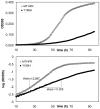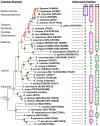The use of orthologous sequences to predict the impact of amino acid substitutions on protein function
- PMID: 20523748
- PMCID: PMC2877731
- DOI: 10.1371/journal.pgen.1000968
The use of orthologous sequences to predict the impact of amino acid substitutions on protein function
Abstract
Computational predictions of the functional impact of genetic variation play a critical role in human genetics research. For nonsynonymous coding variants, most prediction algorithms make use of patterns of amino acid substitutions observed among homologous proteins at a given site. In particular, substitutions observed in orthologous proteins from other species are often assumed to be tolerated in the human protein as well. We examined this assumption by evaluating a panel of nonsynonymous mutants of a prototypical human enzyme, methylenetetrahydrofolate reductase (MTHFR), in a yeast cell-based functional assay. As expected, substitutions in human MTHFR at sites that are well-conserved across distant orthologs result in an impaired enzyme, while substitutions present in recently diverged sequences (including a 9-site mutant that "resurrects" the human-macaque ancestor) result in a functional enzyme. We also interrogated 30 sites with varying degrees of conservation by creating substitutions in the human enzyme that are accepted in at least one ortholog of MTHFR. Quite surprisingly, most of these substitutions were deleterious to the human enzyme. The results suggest that selective constraints vary between phylogenetic lineages such that inclusion of distant orthologs to infer selective pressures on the human enzyme may be misleading. We propose that homologous proteins are best used to reconstruct ancestral sequences and infer amino acid conservation among only direct lineal ancestors of a particular protein. We show that such an "ancestral site preservation" measure outperforms other prediction methods, not only in our selected set for MTHFR, but also in an exhaustive set of E. coli LacI mutants.
Conflict of interest statement
The authors have declared that no competing interests exist.
Figures




Similar articles
-
Computational analysis for the determination of deleterious nsSNPs in human MTHFR gene.Comput Biol Chem. 2018 Jun;74:20-30. doi: 10.1016/j.compbiolchem.2018.02.022. Epub 2018 Feb 27. Comput Biol Chem. 2018. PMID: 29524840
-
The prevalence of folate-remedial MTHFR enzyme variants in humans.Proc Natl Acad Sci U S A. 2008 Jun 10;105(23):8055-60. doi: 10.1073/pnas.0802813105. Epub 2008 Jun 3. Proc Natl Acad Sci U S A. 2008. PMID: 18523009 Free PMC article.
-
Shifting landscapes of human MTHFR missense-variant effects.Am J Hum Genet. 2021 Jul 1;108(7):1283-1300. doi: 10.1016/j.ajhg.2021.05.009. Am J Hum Genet. 2021. PMID: 34214447 Free PMC article.
-
[Molecular genetics of MTHFR: polymorphisms are not all benign].Med Sci (Paris). 2007 Mar;23(3):297-302. doi: 10.1051/medsci/2007233297. Med Sci (Paris). 2007. PMID: 17349292 Review. French.
-
Heterotachy and functional shift in protein evolution.IUBMB Life. 2003 Apr-May;55(4-5):257-65. doi: 10.1080/1521654031000123330. IUBMB Life. 2003. PMID: 12880207 Review.
Cited by
-
Substitutional Analysis of Orthologous Protein Families Using BLOCKS.Bioinformation. 2017 Jan 19;13(1):1-7. doi: 10.6026/97320630013001. eCollection 2017. Bioinformation. 2017. PMID: 28479743 Free PMC article.
-
AlloRep: A Repository of Sequence, Structural and Mutagenesis Data for the LacI/GalR Transcription Regulators.J Mol Biol. 2016 Feb 22;428(4):671-678. doi: 10.1016/j.jmb.2015.09.015. Epub 2015 Sep 25. J Mol Biol. 2016. PMID: 26410588 Free PMC article.
-
Tools for Predicting the Functional Impact of Nonsynonymous Genetic Variation.Genetics. 2016 Jun;203(2):635-47. doi: 10.1534/genetics.116.190033. Genetics. 2016. PMID: 27270698 Free PMC article. Review.
-
Novel insights from hybrid LacI/GalR proteins: family-wide functional attributes and biologically significant variation in transcription repression.Nucleic Acids Res. 2012 Nov;40(21):11139-54. doi: 10.1093/nar/gks806. Epub 2012 Sep 10. Nucleic Acids Res. 2012. PMID: 22965134 Free PMC article.
-
Systematic Mapping of Protein Mutational Space by Prolonged Drift Reveals the Deleterious Effects of Seemingly Neutral Mutations.PLoS Comput Biol. 2015 Aug 14;11(8):e1004421. doi: 10.1371/journal.pcbi.1004421. eCollection 2015 Aug. PLoS Comput Biol. 2015. PMID: 26274323 Free PMC article.
References
-
- Ng PC, Henikoff S. Predicting the effects of amino acid substitutions on protein function. Annu Rev Genomics Hum Genet. 2006;7:61–80. - PubMed
-
- Miller MP, Kumar S. Understanding human disease mutations through the use of interspecific genetic variation. Hum Mol Genet. 2001;10:2319–2328. - PubMed
-
- Grantham R. Amino acid difference formula to help explain protein evolution. Science. 1974;185:862–864. - PubMed
Publication types
MeSH terms
Substances
Grants and funding
LinkOut - more resources
Full Text Sources
Other Literature Sources
Research Materials
Miscellaneous

